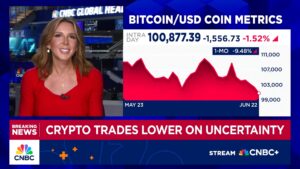Is Solana the Future? Why You Might Ditch Bitcoin for This Altcoin

Solana’s Struggles: Can This Underdog Cryptocurrency Compete with Bitcoin?
Bitcoin’s Recent Surge and Market Dynamics
Bitcoin (BTC) has experienced a remarkable increase of approximately 60% over the past year, currently trading just 7% below its historical peak. This impressive growth can be attributed to several factors, including the influx of investments into spot price ETFs that launched last year, increased purchases by corporations and institutions, and a favorable regulatory environment under the Trump administration, which established a Strategic Bitcoin Reserve. Additionally, Bitcoin is gaining traction as a potential hedge against inflation and geopolitical tensions, with expectations of declining interest rates drawing more investors back into the cryptocurrency market.
Solana’s Underperformance Compared to Bitcoin
In contrast, many smaller cryptocurrencies, including Solana (SOL), have not fared as well. Over the last year, Solana’s value has only increased by about 7%, leaving it over 50% below its all-time high. This raises questions about the reasons behind Solana’s decline and whether it could emerge as a more attractive long-term investment compared to Bitcoin.
Key Differences Between Solana and Bitcoin
Solana operates on a proof-of-stake (PoS) model, similar to Ethereum (ETH), which allows users to earn rewards by staking their tokens rather than mining them, as is the case with Bitcoin’s proof-of-work (PoW) system. This PoS approach is significantly more energy-efficient than PoW. Furthermore, PoS blockchains like Solana support smart contracts, enabling the development of decentralized applications (dApps), games, and non-fungible tokens (NFTs), while PoW blockchains are primarily focused on token mining.
Consequently, the valuation of Solana and other PoS tokens is often driven by transaction speed and the growth of their developer ecosystems rather than token scarcity. Unlike Bitcoin, which is a deflationary asset with a capped supply of 21 million coins—19.9 million of which have already been mined—Solana is an inflationary token with no maximum supply. Currently, there are about 528 million Solana tokens in circulation, with an annual inflation rate of 4.5% that is set to decrease over time.
Solana vs. Other PoS Tokens
While many PoS tokens are built on Ethereum’s blockchain, Solana boasts its own native PoS blockchain, enhanced by a unique proof-of-history (PoH) mechanism that allows for faster transaction processing compared to Ethereum. Theoretically, Solana can handle up to 65,000 transactions per second (TPS), whereas Ethereum’s main layer can manage only about 30 TPS. However, in real-world scenarios, Solana averages between 600 and 1,500 TPS, while Ethereum’s main layer typically processes around 15 TPS. It’s worth noting that Ethereum’s Layer 2 solutions can achieve much higher speeds, ranging from 1,000 to 4,000 TPS.
Despite being the fastest PoS blockchain, Solana’s popularity lags behind Ethereum due to a smaller ecosystem, lack of cross-compatibility with other blockchains, and a steeper learning curve for its primary programming languages, Rust and C. Additionally, Solana has faced more frequent network congestion and outages compared to Ethereum.
Potential Catalysts for Solana’s Growth
These challenges have contributed to Solana’s underwhelming performance relative to Bitcoin in the past year. However, several factors could enhance Solana’s visibility and drive its price upward. Companies like Visa and Shopify have integrated Solana Pay into their platforms, facilitating instant and low-cost stablecoin transactions. Moreover, an increasing number of developers are creating games on Solana that incorporate in-game NFTs and tokens.
New decentralized projects, such as wireless networks and GPU sharing, are also being launched on Solana’s blockchain. Upcoming network upgrades are expected to alleviate congestion and enhance scalability. Furthermore, several crypto firms have recently submitted applications for Solana ETFs, which, if approved by the Securities and Exchange Commission (SEC), could attract significant institutional interest.
Is Solana a Viable Alternative to Bitcoin?
While Solana’s speed and growth potential position it as a more appealing investment than many lesser-known cryptocurrencies, it may not surpass Bitcoin for several reasons. Solana’s inflationary nature, intense competition from Ethereum’s Layer 2 solutions, and lack of cross-compatibility with other blockchains present significant challenges.
In summary, while Solana has promising features and potential catalysts for growth, Bitcoin’s established position, scarcity, and deflationary model continue to make it a more compelling investment choice in the cryptocurrency landscape.







